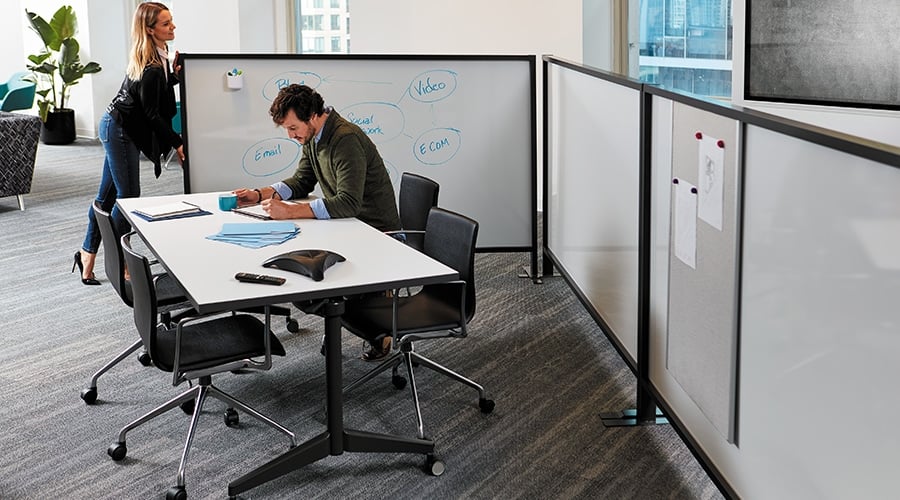Most employees crave flexible workspaces, where they can take office design into their own hands.
The coronavirus pandemic will force employers and employees to rethink how they use flexible shared spaces. More than ever before, employees will be looking for spaces that are clean, comfortable and adaptable. Here’s how employers can meet their needs.
Strike a Balance with Screens
Screens delineate space among workstations, lounges, café-style areas and more. Employees can move freestanding screens around to create a space that maintains a sense of openness or set them up more tightly together for an extra layer of privacy and protection.
- All Terrain Screens: Available in 54-inch and 66-inch heights, All Terrain Screens are equipped with a three-point base with casters, making them easy to move around. Employees can join the screens together with magnetic strips to create a private nook in a snap. The screens are also made of cleanable materials, including markerboard and fluted plastic.
- Connection Zone Screens: Equipped with writable surfaces, an integrated shelf to hold markers and easel hooks to attach writing pads, Connection Zone Screens are great for brainstorming sessions. Employees can use freestanding screens individually or gang them together to define a fluid working space. Surfaces can be solid white or translucent. Varying levels of opacity support daylighting and keep the office feeling open while delineating space.
Keep It Mobile
Designed specifically for employees to control when and how they change up their space, our Tattoo Collection is a one-stop shop for creating a flexible workspace. Each element in Tattoo is proportionately scaled to create various configurations -- from open to isolated and back again.
- Flex Screens: Tattoo screens stand independently and are easy to move, so employees can open up or add more privacy to workstations as needed. They’re available with a variety of inserts, including felt to enhance a space’s acoustics.
- Slim Seating: Modular and lightweight, Tattoo seating empowers employees to create work areas for smaller groups within a larger space.
- Tables: Tattoo tables are designed to work seamlessly with compact Tattoo lounge seating and storage solutions. Employers can pair the tables with booth seating and screens to create private nooks for coffee chats or small meetings.
- Storage: Tattoo storage solutions securely hold personal belongings while doubling as mobile desks for spur-of-the-moment brainstorming sessions.
Movable walls offer a visually striking way to create a flexible space. At KI, we offer three architectural walls: Evoke, Lightline and Genius. Available in a variety of colors and cleanable materials, they offer endless possibilities for reconfiguring space without a renovation.
Sharing Space Virtually
Employers may also want to ensure that their offices support video conferencing with clients and colleagues who want to limit in-person meetings in the wake of the pandemic. KI’s Backbone Media Platform provides a work surface that employers can equip with a flat-screen television or connect to laptops with integrated power outlets.
A Flexible Future
When we return to the office, employees will value control over their physical work environment more than ever before. By imbuing shared spaces with flexibility, employers can ensure their employees feel safe and comfortable while reconnecting with one another.
Click to learn more about KI's product solutions for returning to the office.













